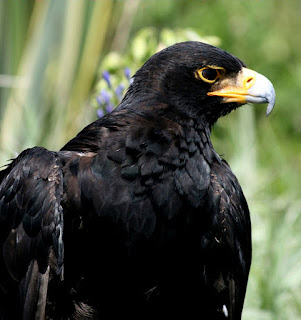The Ground Hornbill: At present Southern Ground Hornbills are considered ‘vulnerable’ but their numbers are still declining.
There are probably only 1500 birds in South Africa—half of which are in the protected areas of the Kruger National Park.
Groups consist of 2—9 birds, of which there is only 1 breeding female.
From which an average of only 1 chick is raised to adulthood every 9 years.
 One of their natural sources of food is snakes which they take and shake vigorously before eating. After this one demonstrated his skill with a rubber one, he went over to his trainer to get his reward.
One of their natural sources of food is snakes which they take and shake vigorously before eating. After this one demonstrated his skill with a rubber one, he went over to his trainer to get his reward. Blue Cranes are the national bird of South Africa. One of the smaller crane species, the Blue Cranes plumage is silvery bluish gray becoming darker on the upper neck and the lower half of the head and nape.
Blue Cranes are the national bird of South Africa. One of the smaller crane species, the Blue Cranes plumage is silvery bluish gray becoming darker on the upper neck and the lower half of the head and nape. Jackal Buzzard - (Please see Philips fantastic photograph and more information.) They nest between May and October in by building a bulky pile of sticks on a cliff ledge or sometimes in trees especially pines. The bowl is lined with leaves and usually two eggs are laid which are chalky white splotched with red-brown.
Jackal Buzzard - (Please see Philips fantastic photograph and more information.) They nest between May and October in by building a bulky pile of sticks on a cliff ledge or sometimes in trees especially pines. The bowl is lined with leaves and usually two eggs are laid which are chalky white splotched with red-brown. They hunt by stooping from flight or gliding from a perch, taking small mammals up to the size of a dassie(hyrax), birds up to the size of a francolin, reptiles, insects, road-kills and carrion.
They hunt by stooping from flight or gliding from a perch, taking small mammals up to the size of a dassie(hyrax), birds up to the size of a francolin, reptiles, insects, road-kills and carrion.During the demonstration it was mentioned that if the female is not satisfied with her male she will kick him out and find a new one. :) How true this is I do not know, but I love the thought. LOL!! (Sorry guys, but its a girl thing!!) :)























